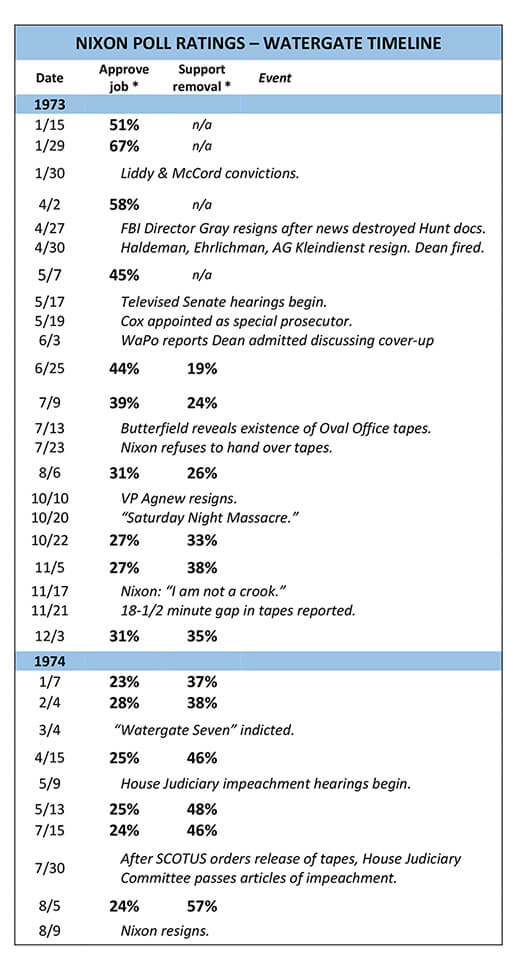by Patrick Murray
It was only a matter of time before a pollster started asking about the possible impeachment of President Trump. But what do these results really mean?
Polling during the Watergate era gives some context. Four decades ago, the public took their cue as much from Congressional leadership’s reaction as from breaking news. In fact, public support for removing Richard Nixon from office did not did not reach a majority until after the House Judiciary Committee passed articles of impeachments – just days before Nixon resigned. Watergate polling also shows that Nixon’s job approval rating hit a hard floor nearly a year before he actually resigned.
Using the Gallup Poll as the barometer, President Nixon’s job approval rating hovered between 57% and 62% during the latter half of 1972. The Watergate break-in and the indictment of its ringleaders were minor news stories that fall as the president won re-election in a historic landslide. Nixon’s job rating bounced around a bit during the first months of 1973, starting the year at 51%, going to 67% after his inauguration and dropping back to a still healthy 58% in early April.
Then the bottom started to fall out. Key advisers resigned or were fired after it was learned that potential evidence was destroyed, coinciding with Nixon’s job approval dropping to 45%. From May to June, the Senate began committee hearings on Watergate, Archibald Cox was appointed special counsel, and reports emerged that John Dean admitted to discussing the cover-up. Nixon’s job rating held steady at 44% in late June, but slipped to 39% in early July.
At this time, Gallup added a poll question specifically on impeachment, with an initial reading of 19% who supported removing Nixon from office in late June. This ticked up to 24% in early July. The existence of an Oval Office taping system was revealed in mid-July with Nixon refusing to hand the tapes over to investigators. His approval rating dropped to 31% in August, while support for impeachment held fairly steady at 26%.
The fall of 1973 brought the infamous “Saturday Night Massacre” and the spectacle of Vice President Spiro Agnew‘s resignation, which was unrelated to Watergate but certainly not a helpful optic. Nixon’s job approval rating fell to 27% in late October and held there in early November. This would pretty much be this metric’s statistical floor for the remainder of his term. Support for removing Nixon from office rose to 33% in late October and again to 38% in early November.
In mid-November, Nixon gave his famous “I am not a crook” speech and the existence of an 18-1/2 minute gap in the White House tapes was revealed. Still, Nixon’s job rating saw an uptick to 31% in December and support for impeachment slipped to 35%. This would prove to be only a temporary reprieve. Nixon’s job rating fell to 23% in January, recovering slightly to 28% in February. Support for compelling the president to leave office held steady at 37%-38% during this time.
In March 1974, the “Watergate Seven” were indicted. Nixon’s approval rating dropped to 25% in April. Support for removing him from office stood at 46%, although it is unclear whether this was truly an increase from February’s result because Gallup decided to change the wording of its impeachment question. Both Nixon’s job rating (24%-25%) and support for his removal (46%-48%) was stable, though, from the spring into mid-July as impeachment hearings got underway in the House Judiciary committee.
After the Supreme Court ordered the Oval Office tapes’ release and the Judiciary Committee actually passed articles of impeachment in late July, support for removing Nixon from office rose dramatically to 57%, while his job approval rating held steady at 24%.
Even when Nixon’s job rating hit bottom in the Fall of 1973, he was able to cling to power on the back of minority support for his removal from office. That is, until Congress started the impeachment process. It’s worth noting that about two-thirds of House Republicans still opposed impeachment in early August 1974 – but they didn’t control the chamber.
In terms of the current state of affairs, the recent Politico/Morning Consult Poll (May 2017) puts public opinion on the impeachment of Donald Trump at 43% support and 45% oppose, while the incumbent’s job rating is 45% approve and 51% disapprove. At first glance it appears that support for impeachment is greater now than it was during Watergate. But there is a huge caveat. The Gallup questions back then specifically gauged public support for compelling Nixon to leave office. The current poll asks whether Congress “should or should not begin impeachment proceedings to remove President Trump from office.”
It will take a lot more polling, with a variety of approaches to question wording on impeachment and removal from office, before we know where the public really stands on this issue. One thing that Watergate teaches us, though, is that public opinion will be unlikely to move significantly unless a critical mass of Republicans in Congress decides that such a move must be made for the good of the country – or at least to save their own political skins.
————————————————————-
* Polling source: Gallup Organization. Dates refer to last day of interviewing for each poll. Before March 1974, Gallup asked: “Do you think President Nixon should be impeached and compelled to leave the Presidency, or not?” After March 1974, Gallup asked: “Just from the way you feel now, do you think his actions are serious enough to warrant his being removed from the presidency, or not?” Results obtained from the Roper center for Public Opinion Research iPOLL database.

